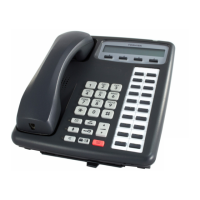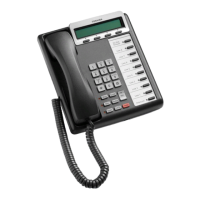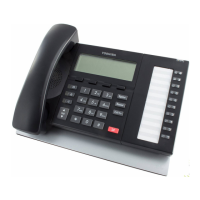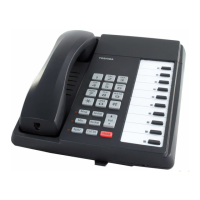TBSU Two-circuit ISDN BRI Interface Unit
DK40 Installation
Strata DK40 I&M Manual Spring 1999
2-35
Refer to the Strata DK40 Programming Manual or DK Library CD-Rom for more details.
TBSU
Two-circuit ISDN BRI Interface Unit
System:
DK40 Base KSU (mounts on KSU TMAU2)
Circuits per PCB:
two circuits (4 B channels - TE or NT)
Interfaces with:
ISDN BRI S/T when connected to the Public Network or a BRI S-
type, TE or TA devices when connecting to ISDN station equipment.
Compatible Slot(s):
slot 12 (Base KSU)
Older Version(s):
none
The Strata DK40 Base KSU only, will support the TBSU interface unit.
TBSU switches, jumpers, and connectors are shown in Figure 2-21 on Page 2-38 and
described in Table 2-9 on Page 2-39.
LEDs on the TBSU show a continuous status of TBSU operation. Refer to Table 2-10 on
Page 2-40 for a list of each LED’s status.
Overview
The TBSU PCB provides the Basic Rate Interface (BRI) circuits for DK40 Base KSU. The
TBSU is plugged in to the main TMAU2 PCB. Each PCB provides two ISDN BRI circuits.
Each BRI circuit provides 2 B-channels + 1D channel for voice/data/video communications.
TBSU circuits are four-wire S/T type circuits and connect to the ISDN BRI lines using an
Network Terminator unit (NT1); or, on the station side, they can connect to ISDN Terminal
Equipment (TE).
TE devices include any ISDN device (telephone, fax, computer) that connects directly to S/T
ISDN BRI circuits.
The TBSU circuits can be configured in one of two ways:
◆ Exchange Line Connection - TE Mode.
◆ S-Bus - NT Mode
The TBSU connection options (BRI line or ISDN TE devices) are selected in DK40 customer
database programming and option switches located on the TBSU.
The network BRI line connection is a point-to-point connection, which means that the
network BRI line can only be connected to one TBSU circuit via the NT1 (T-reference point).
The TBSU circuit that connects to the DK station side, (BRI-NT, S-reference point) allows
direct connection of multiple ISDN (TE or TA) devices. The S point of the TBSU supports
the Toshiba DK passive bus, also known as point-to-multipoint connection. The terminal-side
(S-point) of the TBSU BRI circuit can have parallel connections of up to eight TE’s or TA’s
maximum.
When multiple TE and TA devices are installed on a single TBSU BRI circuit, the devices
must share, or contend for, that circuit’s two B-channels. That is to say, a maximum of two
simultaneous voice and/or data calls are allowed between both devices connected to the same
BRI circuit. The contention rule for the two BRI B-channels is first come, first served.

